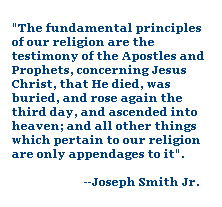 1 Ne. 15: 31-32 And they said unto me: Doth this thing mean the torment of the body in the days of probation, or doth it mean the final state of the soul after the death of the temporal body, or doth it speak of the things which are temporal? And it came to pass that I said unto them that it was a representation of things both temporal and spiritual; for the day should come that they must be judged of their works, yea, even the works which were done by the temporal body in their days of probation.
1 Ne. 15: 31-32 And they said unto me: Doth this thing mean the torment of the body in the days of probation, or doth it mean the final state of the soul after the death of the temporal body, or doth it speak of the things which are temporal? And it came to pass that I said unto them that it was a representation of things both temporal and spiritual; for the day should come that they must be judged of their works, yea, even the works which were done by the temporal body in their days of probation.
I have been thinking a lot lately about what it is that differentiates LDS from other Christians. As you look back at the history of the Christianity, we see the formation of the great Catholic and Orthodox churches with their ritual splendor, ordinances, tradition, and hierarchy. We then see the formation of smaller protestant denominations and non-denominations which have fractured off that have developed a kind of reactionary doctrine against the Catholic Church. While Catholics consider papal authority to be a major basis of their belief, Evangelicals interpret the Bible to teach no hierarchy and no authority but Jesus Himself (except when it comes to collecting tithing).
LDS on the other hand, do not consider authority and hierarchy to be in conflict or mutually exclusive to the "priesthood of all believers" and our individual ability to "approach the throne of God with boldness" as they say. As Nephi says, the things taught in scripture are both temporal and spiritual. And the same thing applies to the concept of the temple, church, priesthood and ultimately God Himself.
This conflict over temporal vs. spiritual is at the heart of the gospel divide even going back to the early church. Back then the Apostles warned against the doctrine of the Gnostic's who denied the physical resurrection of Christ. Such a denial was said to be of the spirit of the antichrist. Why did they deny Christ's resurrection? They rejected it because if Christ had redeemed His physical body and was viewed as the perfect revelation of the Father, then that would mean that the Father also consisted of the perfect harmonization of spirituality and physicality. But to the Gnostic's, matter was inherently evil.
The truth is that nothing is inherently evil but just corruptible. In the beginning we learn that God created all things and he looked upon the whole of creation and declared "It is good." But Christ sanctifies what Satan has corrupted and makes the corruptible incorruptible. Therefore since God encompasses all that is good, and tangible matter is good, therefore God must consist of both a glorified body and spirit. God is spirit, but God is not only just spirit and those who come to God must learn to worship him in spirit (talk) and in truth (walk).
It is this key truth concerning the unifying of the temporal and spiritual which is transcended by the very nature of God which is manifest in every aspect of the gospel of Jesus Christ. The concept of the Church of Christ is an ordered organization but also is the body of believers. The concept of the temple is a sacred structure which administers sacred covenants and serves as a parable and reminder of sacred truth but also represents the indwelling of the Holy Spirit within each individual. The priesthood is divine authority given by God to man to administer the covenants and gifts of God allowing man to act and speak in the name of God, as well as being a power and authority available to all believers who have been called and ordained by the laying on of hands to empower them to approach the throne of God and dwell in His presence. The concept of repentance consists of tangible steps which assist the believer in escaping and forsaking sin as well as the spiritual motivation of the love of God which makes sin loose its enticement.
Again and again in scripture we see the pattern of the heavenly and the earthly manifest. The Law of Moses, Bible prophecy, and the parables themselves are true occurrences which teach and represent a greater spiritual truth. But the lesson of the Old Testament vs. the New Testament was not that the spiritual destroyed the temporal. Christ said He had not come to destroy the law and the prophets but to fulfill. What the New Testament was about was about a restoration of the spiritual and higher law and a unification and a sanctification of the physical.
The Masonic signs of the compass and square represent this truth very well. A compass is used to draw circles. Circles are a shape found in heaven. So, the compass is used to represent heavenly things. The sign of the square is used to draw horizontal lines. The horizon and horizontal lines are something we see terrestrially and therefore represents the Earth and the physical aspect of existence. Therefore the compass and square together represents the unification of the spiritual and physical, male and female, and represents the true nature of God and is reflected in the gospel of Jesus Christ.
 1 Ne. 15: 31-32 And they said unto me: Doth this thing mean the torment of the body in the days of probation, or doth it mean the final state of the soul after the death of the temporal body, or doth it speak of the things which are temporal? And it came to pass that I said unto them that it was a representation of things both temporal and spiritual; for the day should come that they must be judged of their works, yea, even the works which were done by the temporal body in their days of probation.
1 Ne. 15: 31-32 And they said unto me: Doth this thing mean the torment of the body in the days of probation, or doth it mean the final state of the soul after the death of the temporal body, or doth it speak of the things which are temporal? And it came to pass that I said unto them that it was a representation of things both temporal and spiritual; for the day should come that they must be judged of their works, yea, even the works which were done by the temporal body in their days of probation.












1 comment:
This is very helpful. I am a recent convert and this is a focus of study I'm going through lately…delving into the enabling, redeeming and sanctifying powers of the Atonement through sincere repentance. Thank you.
Post a Comment